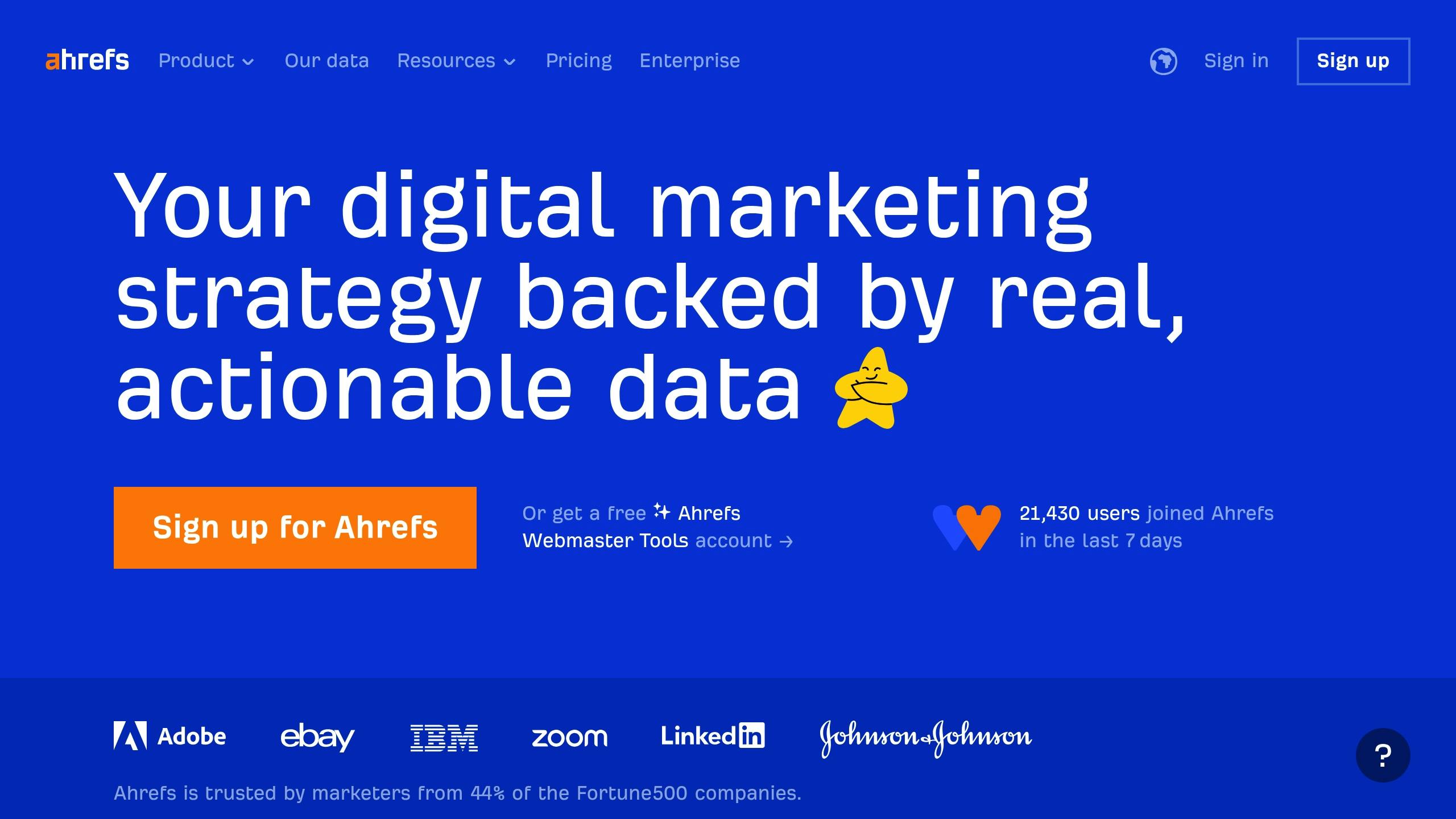-
Why analyze competitor traffic?
It helps you identify market opportunities, allocate budgets better, and learn which content works best. Businesses that do this are 88% more likely to grow year-over-year. -
Paid vs Free Tools:
Paid tools like Semrush, Similarweb, and Ahrefs offer higher accuracy, advanced features, and larger databases compared to free tools. For example:- Paid tools: Up to 95% accuracy, daily updates, and historical data.
- Free tools: 60-70% accuracy, limited updates, and basic metrics.
-
Key Metrics to Track:
- Traffic Sources: Organic, paid, social, referral, and direct traffic.
- Audience Data: Geographic location, engagement, and device preferences.
- Traffic Trends: Seasonal patterns, top-performing pages, and growth trends.
-
Top Paid Tools:
- Semrush: Best for traffic analysis and audience insights. Starts at $117.33/month.
- Similarweb: Great for channel breakdowns and real-time comparisons. Starts at $149/month.
- Ahrefs: Focuses on search and backlink data. Starts at $129/month.
Quick Comparison
| Tool | Strength | Best For | Starting Price |
|---|---|---|---|
| Semrush | Traffic and audience analysis | Overall strategy | $117.33/month |
| Similarweb | Traffic source breakdown | Channel distribution insights | $149/month |
| Ahrefs | SEO and backlink insights | Search traffic optimization | $129/month |
Paid tools provide actionable insights to help you refine your marketing strategy and outpace competitors. Dive deeper into the article to learn how to use these tools effectively.
How to Track Competitor Website Traffic Using Semrush

Traffic Metrics That Matter
When using paid tools to analyze competitor traffic, it’s essential to focus on the metrics that provide actionable insights. These tools offer a wealth of data, but honing in on the right numbers can make all the difference. Here’s a breakdown of the key metrics to prioritize.
Traffic Sources
Knowing where competitors get their traffic can help you spot opportunities in your market. Paid tools like Semrush or Similarweb categorize traffic into specific channels:
| Traffic Source | Insights It Provides | Metrics to Watch |
|---|---|---|
| Organic Search | Performance in search engines | Keyword rankings, landing pages |
| Paid Search | Advertising strategy | Campaign spend, target keywords |
| Social Media | Engagement on platforms | Traffic by network, content type |
| Referral | Partner and backlink success | Top referring domains, link quality |
| Direct | Brand recognition | Branded search volume, repeat visits |
Tracking these channels can highlight what’s working for your competitors and where you might improve.
Audience Data
Understanding who visits competitor sites and how they behave can guide your own strategy. Key audience insights include:
- Geographic Distribution: Identifies the regions driving traffic.
- Device Preferences: Breaks down desktop vs. mobile use.
- Engagement Metrics: Tracks session duration and bounce rates.
- Interest Categories: Shows the topics that resonate most with visitors.
- Socioeconomic Indicators: Provides insights into income levels and professions.
For example, if Similarweb data shows your competitor’s audience prefers mobile browsing, you might prioritize optimizing your site for mobile users.
Traffic Patterns Over Time
Examining traffic trends can reveal strategic opportunities and shifts in the market. Look for:
- Peak Traffic Periods: Times of high activity or seasonal spikes.
- Content Performance: Pages that consistently bring in traffic.
- Growth Trends: Patterns showing long-term increases or declines.
- Campaign Impact: The effectiveness of marketing efforts.
- Market Changes: Broader shifts in industry traffic patterns.
Best Paid Traffic Analysis Tools
Picking the right paid traffic analysis tool can make a big difference in how well you understand your competitors. These platforms provide a range of features to help you analyze market trends and competitor performance. By using these tools, you can gain deeper insights and create more effective strategies based on competitor data.
Semrush Traffic Analytics
Semrush is known for its extensive domain analysis capabilities. Its Traffic Analytics tool provides detailed insights into audience demographics, traffic estimates, top-performing pages, and device usage. This information can help you create targeted campaigns and improve the overall user experience.
Pricing starts at $289 per month for premium features, while the Pro plan for smaller businesses is available at $117.33 per month.
Similarweb Insights
Similarweb focuses on delivering clear, domain-level traffic analysis. It breaks down traffic sources, including organic and paid, and offers detailed audience demographics. You can also track market share in real time and compare up to four competitors side by side.
A seven-day free trial is available, and premium plans start at $149 per month.
Ahrefs for Paid Search

Ahrefs specializes in paid search and backlink data. Its Site Explorer tool is particularly useful for analyzing competitor advertising strategies. You can uncover paid keywords, evaluate landing page performance, and identify gaps in your paid search campaigns.
The Lite plan starts at $129 per month, with advanced features available in higher-tier plans.
sbb-itb-2ec70df
Using Traffic Data Effectively
Leverage your traffic metrics to refine and improve your strategy.
Best Traffic Channels
Tools like Semrush Traffic Analytics and Similarweb can help you understand where your traffic is coming from. Focus on the channels that consistently perform well and drive engaged users to your site.
For example, if organic search is a major traffic source, dig into the keywords driving that traffic using tools like Ahrefs. If paid search is delivering results, analyze your ad strategies and landing page performance to see what’s working.
Here’s a simple framework to help prioritize your channels:
| Channel Type | Analysis Metrics | Action Items |
|---|---|---|
| Organic Search | Keyword rankings, page authority, content types | Improve existing content; create new pages targeting specific keywords |
| Paid Search | Ad spend, converting keywords, ROI | Refine bidding strategies; test new ad copy |
| Social Media | Engagement rates, traffic quality, platform performance | Focus on top-performing platforms; adjust content formats |
Once you’ve nailed down your key channels, the next step is to align your content strategy with those insights.
Content Planning
Use tools like Semrush and Ahrefs to identify which pages and content formats are performing best. Look at page structure, keyword usage, and the type of content that resonates most with your audience.
For instance, if your analysis shows that how-to guides or industry reports get strong engagement, you can create upgraded versions. Add more depth, include updated stats, improve visuals, or make the user experience smoother to stand out.
With your content strategy in place, it’s time to fine-tune your audience targeting.
Audience Targeting
Platforms like Similarweb and Semrush can provide insights into your competitors’ audience demographics, geographic locations, and device preferences.
Use this data to create campaigns that align with these audience traits. For example, if you notice higher engagement during specific times of the day or among certain age groups, adjust your campaign timing and targeting to match those patterns. Tailored campaigns can help you connect more effectively with the right audience.
Growth-onomics Services

Using traffic insights as a foundation, Growth-onomics turns data into practical strategies for growth. By combining industry-standard tools with strategic expertise, they create solutions that align with the analysis steps outlined earlier.
Traffic Analysis Success Story
Growth-onomics combines data from multiple sources to generate insights that drive results. Their process uses top analytics platforms to craft competitor-focused strategies:
| Analysis Phase | Tools Used | Deliverables |
|---|---|---|
| Initial Assessment | Semrush, Similarweb | Competitor analysis and traffic gap identification |
| Deep Dive Analysis | Ahrefs, Data Analytics | Detailed channel performance review and content mapping |
| Strategy Development | Performance Marketing | Actionable steps and a clear implementation roadmap |
This structured approach ensures insights lead to real-world impact.
Growth-onomics Advantages
Growth-onomics helps businesses turn traffic data into growth opportunities by focusing on:
- Search Engine Optimization: Spotting and leveraging organic search potential
- UX Analysis: Using competitor engagement data to enhance site performance
- Customer Journey Mapping: Improving user experiences based on traffic trends
- Performance Marketing: Building strategies rooted in competitor insights
- Data Analytics: Turning complex data into actionable business decisions
Competitor Traffic Analysis Tools
Diving into competitor traffic analysis requires the right tools to get the job done. Premium options like Semrush, Similarweb, and Ahrefs offer insights that free alternatives simply can’t match. Each tool has its strengths: Semrush’s Traffic Analytics lets you compare several competitors side-by-side, Similarweb breaks down organic and paid traffic sources, and Ahrefs focuses on search performance and backlink data.
Key Highlights
Choosing the right tool depends on your business goals and budget. Here’s a quick comparison of these top tools and what they excel at:
| Tool | Strength | Best For |
|---|---|---|
| Semrush | Comparing multiple competitors | Overall traffic strategy |
| Similarweb | Detailed traffic source analysis | Channel distribution insights |
| Ahrefs | SEO and backlink insights | Search traffic optimization |
These tools work together to paint a complete picture of your competitors’ strategies. Using multiple data sources ensures a more thorough understanding of market dynamics. And if you’re looking to turn raw data into actionable plans, agencies like Growth-onomics can help you make the most of these insights.









